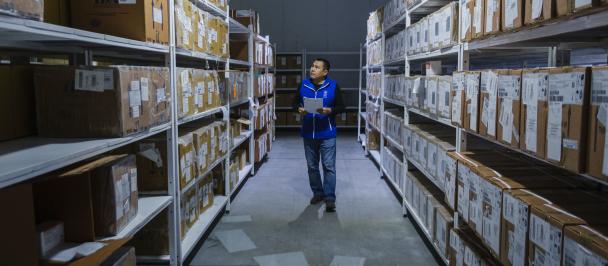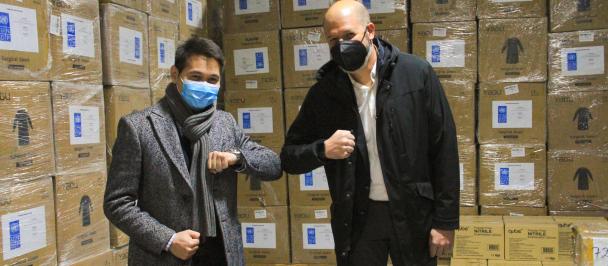Milk factory in At-Bashy, Naryn. Development of production sector in poorest region of the country was supported by UNDP Kyrgyzstan. Photo: Sam Barataliev / UNDP Kyrgyzstan
Kyrgyzstan seems to be well-prepared to pandemics like COVID-19 but remains vulnerable due to unemployment and dependency on remittances.
Indicators such as human development index, healthcare capacity, access to internet, poverty and social protection were used to portray the level of preparedness and vulnerability to COVID-19 in the 189 countries in UNDP’s dashboard “COVID-19 and Human Development”.
The United Nations Development Programme released two new data dashboards that highlight the huge disparities in countries’ abilities to cope with and recover from the COVID-19 crisis. The analysis has been done by using human development index, healthcare capacity, social protection and access to internet.
Preparedness to COVID-19
As seen in the Dashboard 1 on Preparedness, there is a huge disparity between countries with very high human development (HDI) and low human development levels. As for the first category, there are 30,4 physicians, 81 nurses, and midwives per 10,000 people. There are 55 hospital beds available per 10,000 patients. Meanwhile, there are 127,8 mobile phone subscriptions and 18,8 fixed broadband subscriptions per 100 people. These countries account for 12% of GDP to maintain the healthcare system.
At the same time, countries with a low level of human development have only 2,1 physicians, 6 midwives, and nurses per 10,000 patients, and their expenditure on healthcare system accounts for 4,5% of the GDP. These countries have the lowest level of internet access – 67,5 mobile phone subscriptions and 0,4 fixed broadband subs per 100 people.
Where’s Kyrgyzstan in this dashboard?
Kyrgyzstan falls into the category of countries with medium HDI as the country has an average of 45 hospital beds, 18,8 physicians, 64 nurses, and midwives per 10,000 people. The expenditure of the country for healthcare accounts for 6,6% of GDP. This data allows to conclude that the level of preparedness of Kyrgyzstan might be counted as above the average.
In digital means, Kyrgyzstan stands for 122,6 mobile phone subscriptions and 5,6 fixed broadband subs per 100 people which makes it possible to work and learn online.
Preparedness is one thing. But, once a crisis hits, how vulnerable are countries to the fallout? UNDP’s Dashboard 2 on Vulnerabilities presents indicators that reflect countries’ susceptibility to the effects of this crisis.
While countries with HDI lack multidimensional poverty and citizens living below the national poverty line (0%), the least developed countries show an average of 62,3% people experiencing multidimensional poverty and 44% of them live below the national poverty line. The serious disparity is observed with social protection as 86% of people from poor countries do not have access to any of the social protection services.
The COVID-19 pandemic also reminds us that disruptions in one place are contagious, triggering problems elsewhere. For example, in some countries, like Kyrgyzstan, a significant part of their GDP comes from remittances, mainly, from the Russian Federation.
In Kyrgyzstan, 22,4% of people live below the national poverty line and GDP’s dependence from remittances makes up to 33,23% as of 2018. This is mainly accounting for remittances from labor migrants. Thus, the introduction of quarantine in countries where Kyrgyz migrants work will have a strong impact on local GDP.
For comparison, Kazakhstan and Uzbekistan were ranked in higher category in both preparedness and vulnerability. For full information visit official webpage of dashboards.
For more information and media interviews, contact:
Ainagul Abdrakhmanova; ainagul.abdrakhmanova@undp.org; +996770183493
Chyntemir Kalbaev; chyntemir.kalbaev@undp.org; +996775767605
ABOUT UNDP:
UNDP is the leading United Nations organization fighting to end the injustice of poverty, inequality, and climate change. Working with our broad network of experts and partners in 170 countries, we help nations to build integrated, lasting solutions for people and planet. Learn more at kg.undp.org or follow at @undpkg.
ABOUT THESE DASHBOARDS:
These colour-coded tables monitor the level of preparedness of countries to respond to the COVID-19 crisis and their level of vulnerability. The dashboards allow partial grouping of countries by each indicator in the table. For each indicator countries are divided into five groups of approximately equal size with the intention not to suggest threshold or target values for the indicators but to allow a crude assessment of a country’s performance relative to others.
A country that is in the top quintile group performs better than the 80 percent of countries, and country in the middle quintile group performs better than 40 percent but also worse than 40 percent. Five-color coding visualizes the partial grouping of countries and helps users to immediately discern a country performance across the set of selected indicators.
Data presented in these tables come from the official international sources.

 Locations
Locations







